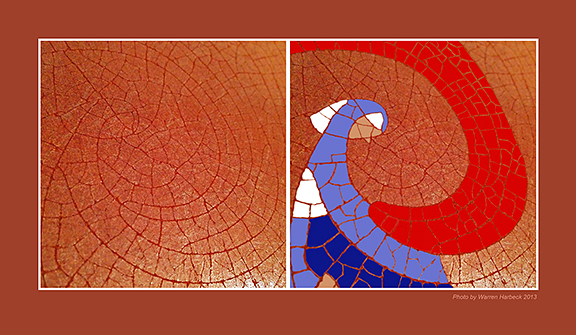
Glazing cracks in dinner plate (left) created mosaic suggestive of the angelic announcement to Mary that she would bear the Son of God. Photo by Warren Harbeck
Intriguing mosaic in an old dinner plate welcomes AdventCOFFEE WITH WARREN, with Warren Harbeck
|
|
|
When I sat down to dinner the other day, angelic announcements were the last things on my mind, but with Advent and Christmas just around the corner, I guess I should have known better. My wife Mary Anna was in the middle of bringing the food to the table when the pattern of cracks in the glazing on the old dinner plate in front of me caught my attention. Its swirling mosaic made me think of distant spiral galaxies similar to our own Milky Way. Was it also allowing me to experience some of the awe Canadian astronaut Chris Hadfield must have experienced when viewing the spiral cloud pattern of low-pressure systems over the southern hemisphere from the International Space Station? Such cracks penetrating the glaze of older dishware and other ceramics are technically known as “crazing.” The art of raku intentionally exploits crazing in the production of pottery traditionally used in the Japanese tea ceremony. Crazing can also be seen as a pattern of fine irregular cracks in the surface of some concrete floors. The crazing in my plate that evening was particularly intriguing. So, as is no doubt an annoying habit of mine, I stopped Mary Anna in mid-serving and asked her to hold my plate at a certain angle while I grabbed my trusty iPhone 5 from my pocket and took a photo of the pattern. I figured I’d play with it a bit on Photoshop after dinner and see what appeared. Well, let me tell you, no one was more amazed than I later that evening at what actually did appear within the mosaic. And no, it had nothing to do with clouds or stars farthest out, but it certainly was heavenly. In processing the image on the computer, I decided to crop it into a square, thinking this would accentuate the “galactic” swirls quite nicely. But the more I looked at the mosaic of crazing before me on the screen the more something totally different began to appear. Within minutes it was absolutely clear to me what I was seeing, and without altering a single line, I began colourizing the individual cells of the mosaic. This coming Sunday marks the beginning of Advent – and of a new liturgical year – in the Christian calendar of many churches. Advent is that season of about four weeks leading up to Christmas, the commemoration of the birth of Jesus Christ. A pivotal event leading into that story is recorded in the first chapter of the Gospel of Luke. That event is known as the Annunciation. The Annunciation refers to the angel Gabriel’s announcement – hence, “annunciation” – to a bewildered young Jewish teenager named Mary that she was going to conceive a very special child, to be named Jesus. Mary was to be the mother of the long-expected Messiah, born to set His people free! “How can this be?” a surprised Mary asks the angel. “I am a virgin.” It was Gabriel’s response to Mary that gripped me as I looked at the image taking shape before my very eyes. “The Holy Spirit will come upon you, and the power of the Most High will overshadow you,” he says. “Therefore the child to be born will be holy; he will be called Son of God.” (Luke 1:35). And there, swirling in from the lower left in the mosaic, the kneeling figure of Mary stood out boldly. I coloured her in shades of blue, a hue long associated with Mary and with Christmas. And the Spirit of God overshadowing her and coming upon her? It was as obvious as could be: the spiral arm originating at the upper left of the mosaic. I coloured that red, a hue symbolic of the Holy Spirit. I named the resulting image “Annunciation: Marian Mosaic in an Old Dinner Plate.” And I offer it to you here, my coffee companions, as a gift to mark the start of this joyous season. I also offer it as a reminder that we may encounter the mysterious sacred in the most unexpected places and moments – even in cracked old dinner plates. So stay alert.
© 2013 Warren Harbeck |